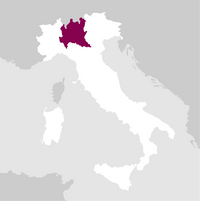奖项
详情

香水

颜色

味道
服务于:
06 - 08 °C.
长寿:
05 - 10 years

搭配
Starters
Fish
Shellfish
Cheese
White fish
生产者
Monsupello
来自这个酒庄
- 创办年份: 1893
- 酿酒师: Stefano Torre, Federico Fermini
- 生产的瓶子: 320.000
- 公顷: 50
Once upon a time, and it's still here. It's 1893 when the Boatti Family in the municipality of Oliva Gessi, in the heart of the Oltrepò Pavese, writes the most beautiful and important page in the history of Italian sparkling wine: at Cà del Tava, one of the great crus of the winery, the seal between Monsupello, Pinot Nero, and Chardonnay is stamped.
Daring what is new, dreaming it, imagining it, and making it real: in the name of the father, Carlo Boatti, and today with his children Pierangelo and Laura. With different sensitivities and attitudes, they are interpreters of future horizons, in the contemporaneity of their sparkling wines. 阅读更多
Daring what is new, dreaming it, imagining it, and making it real: in the name of the father, Carlo Boatti, and today with his children Pierangelo and Laura. With different sensitivities and attitudes, they are interpreters of future horizons, in the contemporaneity of their sparkling wines. 阅读更多


| 名称 | Monsupello Brut Metodo Classico |
|---|---|
| 类型 | White classic method sparkling wine brut |
| 葡萄酒名称 | VDP |
| 容量 | 0,75 l |
| 酒精度 | 13.0% 按体积 |
| 葡萄品种 | 90% Pinot Nero, 10% Chardonnay |
| 国家 | Italy |
| 产地 | Lombardy |
| 供应商 | Monsupello |
| 产地 | Hilly Band of the municipalities of Torricella. |
| 土壤成分 | Clay and limestone. |
| 栽培系统 | Guyot. |
| 每公顷产量 | 9,000 kg/h. |
| 收获 | Second half of August |
| 生产工艺 | Guyot dry pruning is carried out from the end of November, maintaining a number of 8-9 buds per vine. From May, superfluous shoots are removed and the main shoots are tied off; these are basic operations to maintain a good vegetative and productive balance of the plant, especially in the case of young vines. At the beginning of August, after veraison, a light thinning of the grapes is carried out in order to better distribute the vine's production over the shoots closest to the stump and to avoid bunch clusters (the main cause of grey mould attack in wet years); thinning out the bunches, which favours better ripening of the grapes, allows for a greater concentration of aromatic substances as well as a healthier product. For more than 10 years we have been practising the grassing of the vineyards to create a more balanced vine-root ratio and to safeguard insects that are useful to the vineyard; for the same reason, pesticides with a low environmental impact are used and the use of chemical herbicides is avoided. The grapes are harvested by hand, in 18 kg crates. |
| 酿酒工艺 | The vinification begins with the soft pressing of the whole grape, which leads to the separation of the must from the skins; in different containers the juice is seperated (or the first 50% of draining liquid pressing, more fruity, sour and end) from the must of second pressing. The juice, clarified and decanted after about a day, is fermented in steel tanks at a controlled temperature of 18 ° C. |
| 陈酿 | After a period of ageing in stainless steel, the cuvèe of Pinot Noir and Chardonnay undergoes protein and tartar stabilisation and filtration; in the "draught", it is placed in champagnotte bottles together with a liqueur de tirage, composed of wine, sugar and selected yeasts. The bottles are corked with bidule and crown cork and stacked in the cellar to re-ferment at a constant temperature of 14°C; the post-fermentation maturation on the yeast skins lasts at least 30 months, before the bottles are remuaged on pupitres. In the degorgement phase, the bottle is uncorked, the residue of the re-fermentation yeast is removed and the liqueur d'expédition is added; finally, the sparkling wine is corked with a mushroom cork and prepared for sale. |
| 总酸度 | 7.5 gr/L |
| 克/升/升 (LPH) | 3.1 |
| 干提取物 | 28.0 gr/L |






